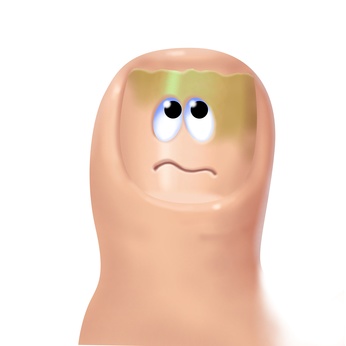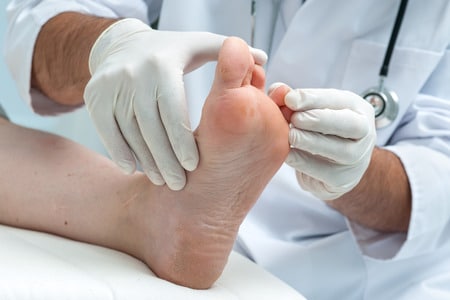Who gets fungal nail infections?
Between 3 and 8 out of 100 people in the UK will have a fungal nail infection at some stage of their lives. Toenails are more commonly affected than fingernails. It is more common in people aged over 55, and in younger people who share communal showers, such as swimmers or athletes.
 How do you get a fungal nail infection?
How do you get a fungal nail infection?
Spread from a fungal skin infection. For example, athlete’s foot is a fungal skin infection of the toes. This may spread to the toenails if the skin infection is not treated early.
Fingernail infection may occur after a toenail infection has become established. The fungus may spread to a finger if you scratch your itchy toes and toenail. Fingernail infections are also more likely to occur if you wash your hands frequently, or have them in water a lot. For example, if you are a cook or a cleaner. Constant washing may damage the protective skin at the base of the nail. This may allow fungi to enter.
A nail that has recently been damaged is also more likely to become infected.
You have an increased risk of developing a fungal nail infection if you have various other conditions. For example: diabetes, psoriasis, poor circulation, a poor immune system (for example, if you have AIDS or are on chemotherapy), or a general poor state of health.
Nail infections are more common in people who live in hot or humid climates. Smoking also increases the risk of developing a nail infection.
In some cases there is no apparent reason. Fungus germs (fungi) are common and an infection can occur ‘out of the blue’.
What are the symptoms of a fungal nail infection?
Often the infection is just in one nail, but several may be affected. At first the infection is usually painless. The nail may look thickened and discoloured (often a greeny-yellow colour). Commonly, this is all that occurs and it often causes no other symptoms. However, it can look unsightly.
Sometimes the infection becomes worse. White or yellow patches may appear where the nail has come away from the skin under the nail (the nailbed). Sometimes the whole nail comes away. The nail may become soft and crumble. Bits of nail may fall off. The skin next to the nail may be inflamed or scaly. If left untreated, the infection may eventually destroy the nail and the nailbed, and may become painful. Walking may become uncomfortable if a toenail is affected.
The website www.dermnetnz.org/fungal/onychomycosis.html has pictures of fungal nail infections.
Treatment does not always cure the infection. Cure rates are about 60-80%.
Treatment that clears the infection does not always restore the nail’s appearance to normal.
The antifungal medicines used for treatment need to be taken for several months – sometimes longer.
Although rare, unpleasant side-effects sometimes occur with antifungal medicines.
The option to treat can be reviewed at a later date if the infection becomes worse or if you change your mind.
However, treatment is usually advised if:
Symptoms are troublesome. For example, if walking is uncomfortable due to an affected nail.
Abnormal-looking nails cause distress.
You have diabetes, vascular disease or a connective tissue disorder (because of a higher risk for secondary bacterial infections and cellulitis).
The nail infection is thought to be the source of a fungal skin infection on your body.
You have, or are likely to develop, severe problems with your immune system. For example, if you are to have certain types of cancer treatment.
Medication
Antifungal tablets will often clear a fungal nail infection. The medication will also clear any associated fungal skin infection, such as athlete’s foot. Your doctor will usually recommend one of the following two medicines. The one chosen may depend on the type of fungus causing the infection. Both of these medicines cause side-effects in a small number of people, so read the packet that comes with the medicine for a full list of cautions and possible side-effects.
Terbinafine tablets. The usual adult dose is 250 mg once a day; for between 6 weeks and 3 months for fingernails, and for 3–6 months for toenails. Visible improvement can be expected after the end of two months of treatment for fingernails and three months of treatment for toenails.
Itraconazole tablets. This is usually given as pulsed treatment. That is, for an adult: 200 mg twice a day for one week, with subsequent courses repeated after a further 21 days. Fingernail infections require two pulsed courses and toenail infections require at least three pulsed courses.
Studies suggest that in about 5 in 10 cases the nail will look fully normal again after treatment. In about a further 2 in 10 cases the fungus will be cleared from the nail after treatment, but the nail does not look fully normal again. Fingernails tend to respond better to treatment than toenails do. One reason for treatment to fail is because some people stop their medication too early.
Antifungal nail paint (nail lacquer)
A nail lacquer that contains the antifungal medicine amorolfine is an alternative for most (but not all) types of fungi that infect nails. You can buy amorolfine nail lacquer from pharmacies as well as getting it on prescription. However, this tends not to work as well as medication taken by mouth. Your doctor will advise if it is a suitable option for your type of infection. For example, it may be useful if the infection is just towards the end of the nail. This treatment does not tend to work so well if the infection is near the skin, or involves the skin around the nail.
The nail lacquer has to be put on exactly as prescribed for the best chance of success. You may need six months of nail lacquer treatment for fingernails, and up to a year for toenails.
Tioconazole is another solution that can be applied to the nail. It can also be bought from a pharmacy, although research trials suggest it does not work as well as amorolfine.
Nail removal
If other treatments have failed, an option is to have the nail removed by a small operation done under local anaesthetic. This is combined with treatment with antifungal medication.
Newer options
Research is looking at newer methods of treating fungal nail infections. These include laser treatment and ultrasound. Initial results are positive but more evidence is needed about the long-term results of the treatments.
What to look out for with treatment
The fungi that are killed with treatment remain in the nail until the nail grows out. Fresh, healthy nail growing from the base of the nail is a sign that treatment is working. After you finish a course of treatment, it will take several months for the old infected part of the nail to grow out and be clipped off. The non-infected fresh new nail continues growing forward. When it reaches the end of the finger or toe, the nail will often look normal again.
Fingernails grow faster than toenails, so it may appear they are quicker to get back to normal. It may take up to a year after starting treatment before toenails look completely normal again and six months for fingernails to look completely normal.
Consult a doctor if there does not seem to be any healthy new nail beginning to grow after a few weeks of treatment. However, the infection can still respond to treatment even after you finish a course of medication. This is because the antifungal medication stays in the nail for about nine months after you stop taking medication.
Tips on nail care if you have a nail infection, with or without taking medication, include the following.
Keep your nails cut short, and file down any thickened nail.
Use a separate pair of scissors to cut the infected nail(s) to prevent contaminating the other nails. Do not share nail scissors with anyone else (for the same reason).
Avoid injury and irritants to your nails. For example, if fingers are affected, use cotton and vinyl gloves for wet work. Use heavy cotton gloves for dry work.
If toenails are affected, wear properly fitted shoes with a wide toe box.
Keep your feet cool and dry as much as possible.
Preventing fungal nail infections
Studies suggest that in about 1 in 4 cases where the infection has been cleared from the nail, the infection returns within three years. One way to help prevent a further bout of nail infection is to treat athlete’s foot as early as possible to stop the infection spreading to the nail. Athlete’s foot is common and may recur from time to time. It is easy to treat with an antifungal cream which you can buy from pharmacies, or get on prescription. The first sign of athlete’s foot is itchy and scaling skin between the toes. See separate leaflet called Athlete’s Foot (Tinea Pedis) for further detail. Also:
Try to avoid injury to nails, which may increase the risk of developing a nail infection.
Wear footwear such as flip-flops in public places, such as communal bathing/shower places, locker rooms, etc.
Avoid towel sharing.
Consider replacing old footwear, as this could be contaminated with fungal spores.
For more information, visit https://www.thenailcure.com/

































